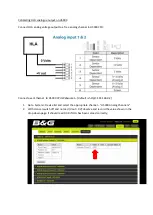
If none of the above methods work in your case, the battery is suspect. Refer to Appendix B to
check and/or replace your battery.
If the battery is replaced, you will need to re-perform the contrast setting described in Chapter 2.
Front Panel Buttons do not give consistent results
Many of the front panel buttons are dual purpose. The second time they are pressed will produce
the alternative menu. These buttons include:
Button
First Option
Second Option
o
USER:
EXIT, CONTRAST,
A-MOVE, TRIGGER,
RS-232C, POWER DOWN
TREND, B-MOVE
o
SCOPE: PROBES SELECT, PROBES
A-MOVE, TRIGGER
ADJUST, ENTER
TREND, B-MOVE
SAVE
SCREEN SAVE
A-MOVE, TRIGGER
TREND, B-MOVE
Note that the second option is always the one beginning with the A-MOVE. This is true regard-
less of the last setting of the USER key. E.g. If the USER key has the EXIT menu chosen, then the
SCOPE key is pressed (resulting in PROBES SELECT), the next time SCOPE is pressed, the screen
will revert to the A-MOVE menu.
Refer to Chapter 3 for a full list of key/menu interactions.
The A460 Switches OFF by itself
The 460 has an on-screen menu option to time itself off. This menu is found by pressing the
USER button, then F4, then ENTER. Notice that the menu gives the user a total of four options.
If an option other that DISABLE has been previously selected, it will remain the selection unless
changed.
To disable the Power Down function, chose DISABLE and then press F4 to record the selection.
Waveform Shapes effected by the 10:1 Probe
The 10:1 probe includes an adjustment which can effect the shape of the waveform you are
measuring. The adjustment is intended to compensate for different levels of input capacitance
(commonly encountered at the interface connection points of instruments). In this subsection we
will look at the effect of this adjustment for different kinds of waveforms.
Figures E-1 through E-3 show three different kinds of waveform: Sine, square, and sawtooth. The
(a) versions of each waveform are those showing the maximum effects of incorrect compensa-
E-2
460 User’s Guide
Troubleshooting



































